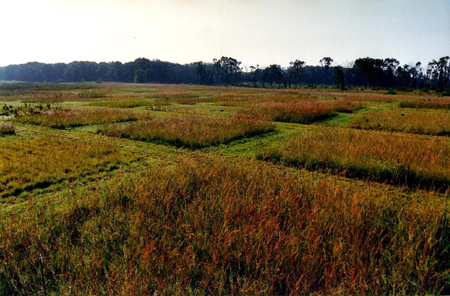OVERVIEW
Cedar Creek Natural History Area is part of the Long-Term Ecological Research (LTER) network. This unique network, funded by the National Science Foundation, supports long-term research at 24 sites located across the climates and habitats in North America and Antarctica (Hobbie 2003).
LTER Mission:
- Understand ecological phenomena over long temporal and spatial scales
- Create a legacy of well-designed and documented long-term experiments and observations for future generations
- Conduct major synthetic and theoretical efforts
- Provide information for the identification and solution of ecological problems
History (from the Cedar Creek Webpage):
Cedar Creek Natural History Area is a 2200 hectare (1 hectare = 2.47 acres) experimental ecological reserve operated by the University of Minnesota in cooperation with the Minnesota Academy of Science. It is located about 50 km north of Minneapolis and St. Paul. Cedar Creek lies at the boundary between prairie and forest. It is a mosaic of uplands dominated by oak savanna, prairie, hardwood forest, pine forests, and abandoned agricultural fields and of lowlands comprised of ash and cedar swamps, acid bogs, marshes, and sedge meadows. The soils of Cedar Creek are derived from a glacial outwash sandplain. Upland soils are nitrogen poor: numerous nutrient addition experiments performed in both old fields and native savanna have shown that nitrogen is the major soil resource that limits plant growth. Cedar Creek has a continental climate with cold winters, hot summers, and precipitation (66 cm/yr) spread fairly evenly throughout the year.
The Biodiversity/Productivity Experiment
This experiment was set up to examine the effects of manipulating species richness (ecologists often refer to the number of species present in an area as the ‘species richness’) on plant productivity and biomass. Human impacts are driving many species extinct locally and globally. These human impacts include habitat loss or fragmentation, habitat modifications such as pollution and introductions of exotic species, and climate change. Fragmentation or fast shifts in climate may limit the number of species that occur in a habitat simply because the seed of that species cannot reach that area. Our experiment is analogous to this situation in that we allow the seed of many species to reach some areas, and restrict the number of species able to reach other areas. We do not focus on the loss of a particular species, but rather ask whether the loss of biodiversity has any general, predictable effects. In particular, we focus on whether biodiversity affects productivity. Productivity here is the amount of plant biomass produced on a given area of land, over a given amount of time. We use aboveground plant biomass as a measure of annual productivity. In our system productivity approximates biomass because no biomass from the previous year survives to the current year, it either dies and decomposes or is consumed in the spring fires we set. Productivity is an important ecosystem trait, as all higher trophic levels depend upon it directly or indirectly as a food resource. In addition, maximizing productivity is a goal of many pasture, forestry, and agricultural systems, and it is possible that insights about the effects of biodiversity can be applied to some of these systems.
The experiment is located in an old field at Cedar Creek Natural History Area, Minnesota. In order to get rid of the existing vegetation and seed bank, the field was herbicided and burned and 6-8 cm of topsoil was removed. The field was plowed and the 168 9 x 9 meter plots were established for this experiment. Each plot was planted with seed of 1, 2, 4, 8, or 16 grassland-savanna species. All plots received, in total, 10 g m-2 of seed in May 1994 and 5 g m-2 in May 1995, with seed mass divided equally among species.

Long-Term Ecological Research Projects
Since its inception in 1982, the overarching philosophy of the Cedar Creek LTER has been, and remains, the synthesis and integration of the principles and processes of population, community and ecosystem ecology. In our original (1981) LTER proposal we said: “Population and community ecology can be greatly strengthened by consideration of the long-term effects, the indirect effects and the feedback effects that the ecosystem approach emphasizes. Similarly, ecosystem ecology can be strengthened by detailed studies of the dynamics of interactions among individual species that play such a key role in the processes of productivity, energy flow and nutrient cycling. We believe this synthesis will only be possible when long-term experimental research combines population, community and ecosystem perspectives.”
We are pursuing this research in five inter-related types of long-term studies: (1) experimental manipulations of plant diversity; (2) nitrogen addition experiments; (3) fire frequency experiments; (4) experimental manipulations of herbivore and predator trophic levels; and (5) long-term observations of soils, plants, insects and mammals in a successional chronosequence and savanna.
References:
- Hobbie, J.E. 2003. Scientific accomplishments of the long-term ecological research program: an introduction. Bioscience 53:17-20.
- Tilman, D., D. Wedin, and J. Knops. 1996. Productivity and sustainability influenced by biodiversity in grassland ecosystems. Nature 379:718-720.
- Tilman, D., J. Knops, D. Wedin, P. Reich, M. Ritchie, and E. Siemann. 1997. The influence of functional diversity and composition on ecosystem processes. Science 277:1300-1302.
- Tilman, D., B. Reich Peter, J. Knops, D. Wedin, T. Mielke, and C. Lehman. 2001. Diversity and Productivity in a long-term grassland experiment. Science 294:843-845.